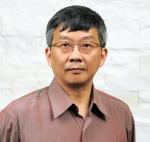Broken Even-Odd Symmetry in Self-Selection of Distances between Nanoclusters due to the Presence or Absence of Topological Solitons
- Citation:
- Lai, M. Y., Chou J. P., Utas O. A., Denisov N. V., Kotlyar V. G., Gruznev D., Matetsky A., Zotov A. V., Saranin A. A., Wei C. M., & Wang Y. L. (2011). Broken Even-Odd Symmetry in Self-Selection of Distances between Nanoclusters due to the Presence or Absence of Topological Solitons. Physical Review Letters. 106, 4., Apr, Number 16
Abstract:
Depositing particles randomly on a 1D lattice is expected to result in an equal number of particle pairs separated by even or odd lattice units. Unexpectedly, the even-odd symmetry is broken in the self-selection of distances between indium magic-number clusters on a Si(100)-2 x 1 reconstructed surface. Cluster pairs separated by even units are less abundant because they are linked by silicon atomic chains carrying topological solitons, which induce local strain and create localized electronic states with higher energy. Our findings reveal a unique particle-particle interaction mediated by the presence or absence of topological solitons on alternate lattices.
Notes:
ISI Document Delivery No.: 757ODTimes Cited: 0Cited Reference Count: 21Cited References: Bird CF, 2003, PHYS REV B, V68, DOI 10.1103/PhysRevB.68.115318 Bunk O, 1998, APPL SURF SCI, V123, P104, DOI 10.1016/S0169-4332(97)00472-8 Chang HH, 2004, PHYS REV LETT, V92, DOI 10.1103/PhysRevLett.92.066103 Fukaya Y, 2003, PHYS REV LETT, V91, DOI 10.1103/PhysRevLett.91.126103 Hwang GS, 2000, SURF SCI, V465, pL789, DOI 10.1016/S0039-6028(00)00757-3 Li Jian-Long, 2002, Phys Rev Lett, V88, P066101, DOI 10.1103/PhysRevLett.88.066101 Kotlyar V G, 2003, Phys Rev Lett, V91, P026104, DOI 10.1103/PhysRevLett.91.026104 Lai MY, 1999, PHYS REV B, V60, P1764, DOI 10.1103/PhysRevB.60.1764 Lai MY, 1998, PHYS REV LETT, V81, P164, DOI 10.1103/PhysRevLett.81.164 Lai MY, 2001, PHYS REV B, V64, DOI 10.1103/PhysRevB.64.241404 Liu F, 2001, PHYS REV LETT, V87, DOI 10.1103/PhysRevLett.87.126103 Moller FA, 1996, PHYS REV LETT, V77, P3165, DOI 10.1103/PhysRevLett.77.3165 Qin XR, 1997, SCIENCE, V278, P1444, DOI 10.1126/science.278.5342.1444 RAMSTAD A, 1995, PHYS REV B, V51, P14504, DOI 10.1103/PhysRevB.51.14504 Sagisaka K, 2003, PHYS REV LETT, V91, DOI 10.1103/PhysRevLett.91.146103 SHCHUKIN VA, REV MOD PHYS, V71, P1125 Smith AR, 1996, SCIENCE, V273, P226, DOI 10.1126/science.273.5272.226 Utas OA, 2010, SURF SCI, V604, P1116, DOI 10.1016/j.susc.2010.03.025 Wang YL, 2008, INT REV PHYS CHEM, V27, P317, DOI 10.1080/01442350801943708 WOLKOW RA, 1992, PHYS REV LETT, V68, P2636, DOI 10.1103/PhysRevLett.68.2636 Yokoyama T, 1999, PHYS REV B, V59, P12232, DOI 10.1103/PhysRevB.59.12232Lai, M. Y. Chou, J. P. Utas, O. A. Denisov, N. V. Kotlyar, V. G. Gruznev, D. Matetsky, A. Zotov, A. V. Saranin, A. A. Wei, C. M. Wang, Y. L.National Science Council, Taiwan [97-2923-M-001-003-MY3, 96-2120-M-001-002]; Russian Foundation for Basic Researches [08-02-92000, 09-02-98500, 09-02-00094]We thank K. P. Liu and Anthony Merer for fruitful discussions. This work is supported partly by National Science Council, Taiwan (Grants 97-2923-M-001-003-MY3 and 96-2120-M-001-002) and Russian Foundation for Basic Researches (Grants 08-02-92000, 09-02-98500 and 09-02-00094).AMER PHYSICAL SOCCOLLEGE PK

